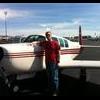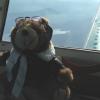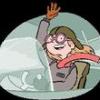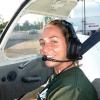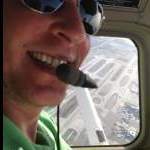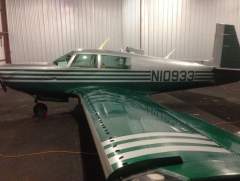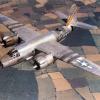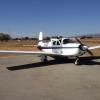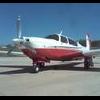Leaderboard
Popular Content
Showing content with the highest reputation on 06/18/2013 in all areas
-
Arrival and departure into CLT (Charlotte/Douglas International) in a Mooney M-20 with ATC audio. Landing runway 23 and departing runway 36R. http://youtu.be/L_OK9o_ae-84 points
-
Now that you mention it. There are a few give and takes that come to mind.... At least in the landing phase. Takes: More Patience... More Precision... More Practice... Gives: More capabillities... More speed... More distance... More load... Speed control. The long body has more mass, speed and energy to be aware of to handle properly. My C used 75 mph. My R uses 75 kias. Sounds similar, but... Increase of speed is approx 15% Increase of mass more than 20% Increase of momentum is significant.... dm x dv Increase of stopping distance is bigger when mistakes are made. Key things to remember... Runways have stayed the same. Gravity still works the same. Apps have been invented to make W&B and density altitude easy calculations. There are flight recorder apps that can help you review your performance. Stay ahead of the plane, like before, but with more reason. That's my take on it. Transition was 65C ---> 94R Make sure your stall horn is working. Mine went on hiatus when I first got my O. Am I close, or did I go on a 310hp/TopProp rant??? That would be more in the T/O phase.... Best regards, -a- Cris' input above is from a top shelf, real flight instructor. My input is from ordinary PP experience. Be careful if you train with Cris' in his plane. The ATP/310HP/TopProp combination is inspiring....2 points
-
Hi Everyone! Sorry I've been MIA; it's getting difficult to update all the forums, but I wanted to let you know where I am these days with my airplane hitchhiking project! As of writing this, I just hitched a flight from Kitty Hawk to Norfolk, marking state #27. I am trying to head to New England next, hopefully Oshkosh in July and Alaska in August (somehow). For those of you who aren't familiar, I am a travel writer who is hitchhiking on general aviation planes in an effort to visit all 50 states. I started in July 2012 and am blogging about the adventure on JetHiking.com and a book is in the works. Speaking of the website, I just re-launched JetHiking.com so it should look much better on all those smartphones! I'm still working out a few kinks, but it's getting there. I also bought a Go Pro camera so I'll be video blogging very soon. I'm editing a hang gliding video right now. You can check out which states I've been to here: http://jethiking.com/about/what-is-jethiking/ I had a blast at Sun N Fun in April, and have been hanging out in South Florida for the month of May working as a bartender and as a deckhand on a sailboat so I have the funds for part two of the journey. Thanks to everyone who has helped with the trip and for all of your kind e-mails and support! The adventure continues.... Amber2 points
-
I have bought a few books to help gain knowledge, and I decided to take my first XC since the St Louis fiasco. I went from Millington, TN to Elizabethton, TN to visit a friend at his cabin. The trip there went off without a hitch. The Elizabethton airport was surrounded by mountains and pattern altitude was around 2600 feet, which mountain flying is something new to me. In route, it was showing the mountains at around 4500’, so I went over them at 6500’ to err on the side of caution since I know about downdrafts, but I don’t know how close to the tops I could have went since I have no mountain experience. On the return trip the weather was showing prior to departure: Ceilings at 6000’ in Elizabethton, 10 Vis, winds calm. In route before Nashville, the ceilings showed 10,000’, 10 vis. Then after Nashville all the way to Memphis 25,000’ Well, that entirely was not the case. After takeoff, I climbed to 4,500 and started seeing a lot of buildup. Everything was fine higher up, so I climbed to 6,500 flew that for a while, then saw another layer ahead of me, but everything looked good higher up so I climbed to 8,500’ and flew that for a while until I saw another layer ahead, and everything looked good below, so I stepped down to 6500’ and kept repeating this process until 3500’. I tried calling a briefer, but he would not answer on the 2 frequencies ATC have given me, so I just kept checking the stations ahead of me. Guess what? Skies clear until 25,000 on every station I kept checking. ATC even helped me out checking the stations in route and kept getting the same thing I was getting, but there was multiple layers of clouds, and I even went through a little rain when ATC was showing no precipitation. As I got closer in, I started to see some cumulous buildup, that appeared to be the beginning stages of thunderstorms, so I steered clear of those. My buddy left an hr after I did, and has the same experience as I did. Good weather report, but the same conditions that I was in. He has been flying for 30 years, and he said this has happened to him maybe 5 times “bad weather reporting” like on Sunday. I did experience some heavy haze, but visibility was still at least 10 miles, and I managed to stay within the legal VFR limits. This time around, I was aware of the illusions I was getting from the haze from my last experience, so I handled it a lot better this time. Lessons learned: Look at the weather report, but trust what you actually see. Don’t count on ATC as a reliable weather source. I now look at my PPL as a “good luck” license. As a PPL, you can mitigate most risk with good weather planning, preflight, etc… But it also takes luck until you gain experience, and you can’t get experience without flying and going through it. So it’s a catch 22 As always, I will keep you guys posted on my journey to be a proficient, safe pilot.1 point
-
Will this technique help lower the cost of aircraft parts, and airframes? Printed Airplane Parts (from AvWeb) China's AVIC Heavy Machinery has produced what it claims to be the world's largest titanium aircraft part critical to an aircraft's structure printed from a 3D printer -- and with massive cost savings. The part, displayed at the 16th China International High-tech Expo, fits a J-20 or J-31 stealth fighter. According to the company, the titanium alloy structural part costs $212,000 to produce through 3D laser direct manufacturing, versus $1.3 million through traditional methods. China's C919 passenger jet, which is expected to enter service in 2016, will incorporate a five meter-long titanium printed wing spar. The company also made bold claims about the potential benefits of printed parts in U.S. military aircraft. The company also postulated that if titanium parts in American F-22 Raptors were built with printed (instead of forged) parts, they could see a weight savings of roughly 40 percent. It says that compared with conventional techniques, savings could reach 90 percent of materials and costs. Parts produced through the 3D printing process allow for more efficient component design optimized for both strength and weight savings, the company says. The process is not without its critics regarding the application of printed parts as structural components. Historically, forging is considered to produce a stronger part. AVIC's 3D printing technology can produce parts using titanium alloy and high-strength steel. It has been used to create parts in at least seven aircraft designs and those parts have served in load-bearing capacities. In the U.S., GE has started to develop manufacturing processes for jet engine fuel nozzles. The parts are expected to be 25 percent lighter and five times stronger than traditional parts. The nozzles are expected to appear in GE LEAP jet engines, which hold 19 nozzles each.1 point
-
From the album: N10933
Best wax product I have found yet. Maguires "Ultimate Wax" - goes on as a quick applicate paste and then is the easiest paste wax removal I have ever used. I did the whole plane by hand in 1:15 including 2 applications to the wings. And it really looks good for such an easy wax. I highly recommend. By the way, that is not a particular new paint job you are looking at...1997 paint.1 point -
I got tired of my Mooney fuel gauges and decided to replace them with an aerlogic digital fuel gauge. For those who don't know the company (at least I did not know them until recently) here is there www side. http://www.aerospacelogic.com/ Good customer service and great quality. Just make sure to request a discount when you purchase something from them... (I did not and later I learned that I could have...). Installation of the unit was easy. What takes a long time is calibration... You have to empty the tanks and then add 2 gallons at a time. Of course there is always something that goes wrong... and you have to start from scratch. So last weekend I went flying and I tried the unit in the real world. It really works great. The only problem are the fuel senders...if they are not in good shape the indication may not be as accurate as you would hope, but that was to be expected... Mine seem to be old and not as reliable, so (as mandated by the FAA) they indicate full and empty, and in between... well.... Another interesting thing is that because I added a 5 gallon bladder to each side of the wing to my 26 gallons, the fuel senders consider that the tank is full as soon as it raches 26 gallons and not 31. So from 31 until I consume about 7 gallons the tank indicates "full". Conclusion: despite these little observations I am very happy with the unit and I would recommend it to anybody who wants to get a better sense of how much fuel do you really have in your tanks (complemeting my jpi 830), Oscar1 point
-
Robert -- Tom has provided you some insights into the world of cross country flying. You bought a plane that was designed to do long trips. You didn't buy a trainer designed to get you your PPL. What that means to you is that you will need to become a student of weather like most of us did who wanted to get utility out of our airplanes. Whether you are VFR or IFR rated, you need to understand the variables associated with the ever changing environment we are in -- the weather. Learn how to read the skew-t, prog charts and other tools that are at your disposal. Even if you go out and get your IFR rating, that doesn't mean you still won't fly into the side of a CB. You need to understand what Mother Nature is tossing your way and be man enough to know when she is the boss.1 point
-
If you want their discount go on the webpage contact them over chat and ask for the web discount. First time I called was over the phone and they did not give it to me.1 point
-
Don't forget rope so you can hang yourself about halfway through the job. I vote for Weep-No-More! If it were me, I'd arrange for Paul to do it while you're deployed and that way you can enjoy the plane when you get back instead of wrestling with it for several weeks huffing MEK and cussing up a storm.1 point
-
1 point
-
The main difference between what you have been flying and the long body is how it sits on the ground. The following is from Trey Hughes Pilot review of the M20R. "When we talk about landings in the Ovation or any of the new generation long body Mooneys (M20M, M20R or M20S) we must talk about the landing attitude. As I mentioned earlier, the long bodies sit with about a positive 4.5 degrees pitch attitude on the ground. Pilots moving into the newer aircraft from one of the shorter length Mooneys (M20K or earlier) will immediately notice this difference when they first sit in the cockpit. Now thinking about sight picture and pitch attitude during the flare for landing, most aircraft will need about + 5-degrees during the round out to keep the nose wheel off the runway until the mains are on. This works quite well for all the Mooneys except the Ovation, Eagle or Bravo. With an almost 5-degree nose up attitude sitting level, the pitch attitude is going to need to be higher during landing in order to land on the main wheels before the nose. One of the biggest transition problems I have found for pilots moving into these long Mooneys is the landing – more specifically, landing on the nose first or all three simultaneously. Either action can quickly lead to a porpoise and the outcome of this isn't very pretty. Pilot must develop a different sight picture when landing these new Mooneys. Where 5-degrees worked before, 8-degrees is necessary now. This just takes practice and the help of a competent instructor familiar with long-body Mooneys. As with all Mooneys, airspeed control during the final approach is key. Fly too fast and the airplane will float on a cushion of air forever. " Also you will find that if your landing speed is 75 Kts at gross it needs to be about 5 Kts less when 300 lbs less than gross. If you are on airspeed with full flaps you will have max trim up which will set you up nicely for a landing with very little flare required. Be prepared for significant control input in a go around until you take out the trim. Basically your sight picture will be the horizon as you touch down.1 point
-
Thanks for all the kind comments! I did have a few controllers en route confirm if I was actually going to the "big airport" in Charlotte, but CLT was a very nice stop after a long day of flying (that started at 6am at BTR and ended about 8:30pm in CLT). Flying in was very uneventful even though I didn't come in during the published slow times. I used to be based at HOU and found ATC at CLT to be much more accommodating; not once was I asked to expedite or for best forward speed (although I kept 125 KIAS till a 3 mile final then slowed to 100 and 90 on short final). The FBO, Wilson Air is great. I took on about 35 gallons at a very reasonable $6.30/gal, paid no ramp or overnight fees (I don't recall exactly what they were, but they weren't bad if I'd had to pay them). They drove me and my passenger to a nice Hilton where they had an $89/night crew rate and picked us up in the morning. They also gave me two soccer balls for free. At Bravo airports I usually do a run-up on the FBO's ramp, but they said they city doesn't allow this, so I had to do it a few feet away on the taxiway. Departure was equally uneventful. I was #10 for departure, but it was only about an 8 minute wait... I've been #1 for departure at TEB and HPN want waited longer for my IFR release. -Andrew1 point
-
Sounds like your on your way!! Fly it hard for a bit and the cylinders should last a good 1200+hrs. Enjoy the new Cylinders, more importantly enjoy not thinking of where all the oil was going. Best.1 point
-
I'll PM you my bank account number - would you be wanting my credit card number too I presume? :-)1 point
-
Nexrad displays much better on an iPad, even an iPhone than the Aera 500. Its usable on the Aera, but if there's weather, Im using the iPhone to watch it.1 point
-
Our fresh factory engine was about 5-7 knots slower until about 45 hours when everything finally broke in.1 point
-
I saw one of those props and wondered what the trailing edge tabs were for.1 point
-
1 point
-
I took mine from Wichita to Maxwell's shop in Longview TX for the PPI 6+ years ago.1 point
-
I have been a pilot for 25 years and I get a little quezy if I am a passenger. Especially in boats and the back of cars or buses. But if I am in control of the boat car or airplane it's never a problem. I would guess its because my brain knows what's going to occur before it does. Maybe let you son take the controls on the cruise portion and see if that helps, Don't let it discourage him, and take it easy on the controls and weather. An old airline guy told me " he tries to fly in such a way that the business guy in back never looks up from his paper even on landing"1 point
-
The guy in the video did a good job recovering from the stall. I bet his passengers will never want to fly with him again.1 point
-
My father let loose with some Mooney factory stories last night and I couldn’t wait to share some of them with the board. He was hired into Mooney as a draftsman (didn’t know that) out of Embry Riddle. He had his PPL and A&E ratings. Not sure what an A&E is but I guess similar to A&P. One of his first accomplishments was a small redesign of the Johnson Bar. He said every plane starting in ’65 has a better “mechanical advantage” than previous years because of his rework. Something to do with a ‘slot’ he incorporated into the existing handle design that made it easier to get the gear up and locked. Evidently it was a known issue of the difficulty getting the gear up and they put him to work on it soon after he came onboard. Another early design change he said he was completely responsible for was converting the retractable hand crank step to a vacuumed design. He said it took him a day to conceive and draw out plans, but took some time to make it a reality. He said he worked on the boot for awhile to make it reliable. He said the wing leveler boots, and the step retract boot were from the same company and he worked with them on the application and manufacture to make it reliable. He tried hard to remember the name of the manufacturer but couldn’t. He gave out names, which I didn’t write down, of chief engineers and others and how they would work on M20 refinements and said they could roll off the assembly line a plane a day in 1967. What got my attention the most was when he started to talk about the M22! Evidently there were two departments working on the design. One was Power plant and it systems, and the second was airframe and its systems. The big question/issue was the voltage. 28 or 14 volts? He said he was not happy with the 24 volt decision but it was made so he had to work around it. He said it added weight and complexity that was not needed. He gave an example. The landing gear motors on the M22 were the same motors as used on the Lockheed Electra. A known proven part at the time and readily available. Problem was, they were 14 volts. They had to be rewired for 24 volts. This equaled one of the cost overruns that stressed the project. Another was the rectangular frame on the 22. As he says it, “we had to use a lot of dupe for it to hold pressure” which added weight. He submitted designs to the chief engineer more than once to make a tube design out of the roll cage as opposed to the rectangular design. Those designs were rejected as he was told they were not “Mooney enough” for management. I thought that was interesting that my dad could have changed the course of the Mustang if the plane would have performed just that much better. If, if , if……. Anyway, I found this Mooney history very interesting as I had no idea how involved my dad was with Mooney. I always thought he was on the floor, not upstairs actually putting pen and slide rule to paper helping to define the Mooney experience. On a side note, it is amazing to me how he almost has the memory of a computer. Names, dates, and details he pulls right up. I can't remember what I had for dinner! I am jealous. I guess that is why he is the engineer and I am not1 point
-
Mooney is specific enough of an aircraft as a make that it would be hard to imagine "settling" for any one of their models!!! I suppose if I had FU money, I'd have a Gulfstream G650 for long range travel, a Pilatus PC12 for shorter range or unimproved but longer strips and a Huskey or C185 for backcountry flying. I'm on a military salary, I struggle to keep my J airborne... But it's a worthy struggle!1 point
-
In 9000 hours I cant tell you a story about landing a 172 with an inch of ice, but I can tell you a story where in Kingman, AZ we were picking up mixed ice in a Beech 1900 at the rate of about 3 inches per minute. IDK about you guys, but Id prefer to be more than a couple minutes away from the end of my life.1 point
-
Quote: allsmiles Ditto Bennett! Really nice panel! I like the flush mounted JPI. Is this from JPI or something rigged by the shop? How do you use the 430? As #2 totally independent of #1? I guesss you'd have to right because it doesn't talk to the 750 or does it? Very nice! Congratulations and enjoy!1 point

